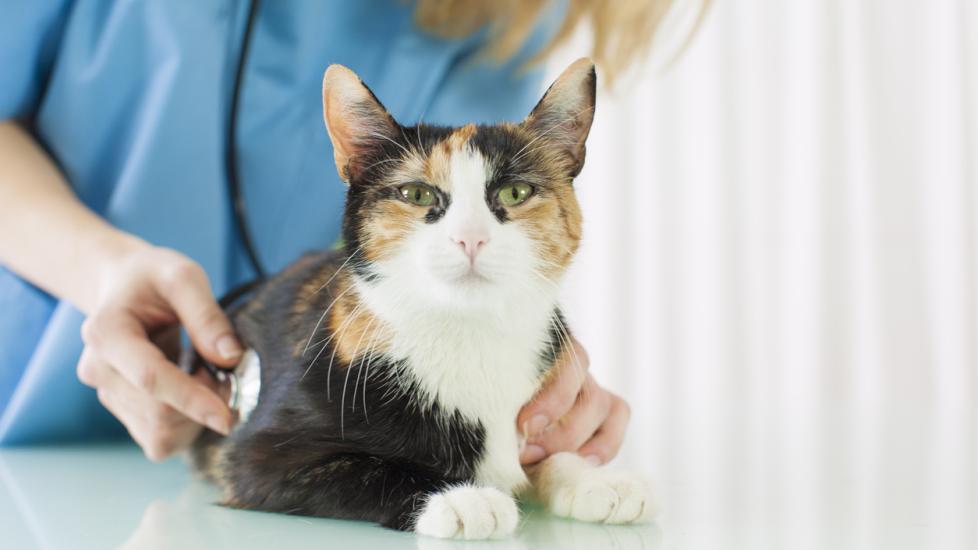Lumps on Cats: How Veterinarians Diagnose Lumps and Bumps
What Are Lumps on Cats?
Lumps and bumps are a common reason why you might take your cat to see their veterinarian. The broadest grouping to categorize lumps and bumps is if they are benign (non-cancerous) or malignant (cancerous) in nature.
While some lumps are slow-growing, others may grow rapidly. Lumps can be raised or flat on the surface of the skin or they can be under the skin. Some lumps and bumps are painful or itchy, and others can go unnoticed by your cat; you may simply find them when you are petting or brushing them.
While your veterinarian might be able to make an educated guess as to what the lump or bump is, the only way to know for sure is with basic skin testing. Skin testing in cats can be non-invasive and done during a routine vet visit, while other skin diagnostics require sedation or even general anesthesia for a more invasive surgical procedure.
Once your veterinarian diagnoses the nature and cause of your cat’s lump, they will design an individualized treatment plan. This can be as simple as oral medications (such as antibiotics, antihistamines, or steroids) or as complex as a surgical removal. If you notice a new lump or bump on your cat, it is always recommended that you have it examined by your veterinarian.
Vet Recommended Health Support
- Douxo S3 CALM Soothing Itchy, Hydrated Skin Dog & Cat Mousse, 5.1-fl oz bottle$24.99Chewy Price
- Purina Pro Plan Veterinary Diets FortiFlora Powder Probiotic Digestive Supplement for Cats, 30 count$30.99Chewy Price
- Purina Pro Plan Veterinary Diets Hydra Care Liver Flavored Liquid Supplement for Cats, 3-oz pouch, case of 12$14.99Chewy Price
- Purina Pro Plan Adult Sensitive Skin & Stomach Lamb & Rice Formula Dry Cat Food, 7-lb bag$28.08Chewy Price
Common Benign Lumps and Bumps on Cats
Some common types of non-cancerous lumps and bumps found in cats:
Traumatic
Lumps can form on your cat’s body if they accidently injure themselves—for example, by bumping into something or not landing on their feet after a high jump. There are some vaccines that can leave a bump after the injection. Depending on the severity of the lump or bruise, your cat might need some pain medication, but often these lumps go away within a few days without bothering your cat at all.
Infectious and inflammatory
Fungal infection: Most fungal infections in cats affect their lungs, but some can also cause lumps under the skin with or without a draining tract of infection to the surface of the skin. Antifungal medications can be prescribed by your veterinarian and might need to be continued long-term to ensure that the fungus has been removed from your cat’s body.
Parasitic or insect bite: The most common bites on a cat’s skin are from fleas, ticks, mosquitoes, and mites. These lumps are often red and raised, and you might even notice the live flea, tick, or mosquito on or near your cat. These bites often resolve without treatment, but they are still a concern. Prevention medications, such as Revolution® Plus and Bravecto®, can help decrease the incidence of these types of bites.
Abscess: An abscess is a lump formed from a pocket of infection that has been walled off by the body to help prevent spread of that infection. Abscesses can occur in areas where your cat has been scratched or bitten. These red bumps are often painful and can make your cat feel ill, causing appetite and behavior changes. Your veterinarian may advise you to apply a warm compress and prescribe medications such as antibiotics and anti-inflammatories. Some deep abscesses may require surgery.
Granulomas: Eosinophilic granulomas in cats are circular yellowish or pink raised bumpy areas of inflammation. They are most often found on a cat’s head, face, lips, or mouth, but can form anywhere. These granulomas often occur as part of a complex of conditions, which together are called an eosinophilic granuloma complex. Eosinophilic plaques are red, raised lumps often found on a cat’s belly and thighs that are often very itchy and bothersome. This complex of bumpy skin conditions often occurs from an allergic hypersensitivity.
Hives: Hives in cats are associated with an allergic reaction, often to insects or medications. These bumps are usually small patches of red swollen skin that are typically very itchy and bothersome to your cat. Hives can come from inhaling, ingesting, or physically contacting a known allergen. With hives, other body systems are also often affected, and you may notice changes such as the way your cat is breathing—for example, rapid or open-mouth breathing. Treatment may not be required if the skin bumps come and go very quickly, but if your cat’s behavior or breathing changes or the bumps last more than a few minutes, seek veterinary attention.
Pyoderma: A pyoderma is a bacterial skin infection that causes small, red raised bumps on the skin called papules. Pustules are similar to papules but have a soft, white center and are often filled with pus, similar to human or pet acne. This is usually in response to normal bacteria on the skin overgrowing in response to an allergy or any condition that causes itching, such as self-trauma. Oral and/or topical antibiotics are often curative if the underlying cause is treated as well.
Cysts
Cysts are similar to abscesses, except the material inside is not infectious. Cysts on cats cause lumps that are often filled with fluid or thicker material such as keratin, a skin protein. Cysts are raised bumps that are soft to the touch and might look like a plugged hair follicle or even like a wart. Cysts can grow rather large and even rupture and become infected. Cysts often have to be removed surgically, depending on severity and location.
Lipomas
Fatty tumors, or lipomas, are soft lumps under the skin that are often slow-growing and freely movable when touched. Lipomas are frequently found on a cat’s abdomen, but can be found on the neck as other parts of the body where fat tissue is present. Since these are benign and unpainful tumors, they are monitored and surgically removed only if they are causing a problem to your cat.
Skin tags
Skin tags are bumps that form on the skin from an overgrowth of skin cells. These slow-growing, small lumps can occur anywhere on the body and do not tend to bother your cat. These lumps are usually pink or white in color, are rather small, and can be rough or smooth on the surface.
Common Malignant, or Cancerous, Lumps and Bumps on Cats
The following are some common types of cancerous lumps and bumps that can be found in cats:
Mast cell tumors
Mast cell tumors are a common skin tumor found in middle-aged cats. These lumps can be single, hairless, and skin-colored or multiple, small, firm lumps under the surface of the skin. Surgical removal is recommended for these lumps, as they can spread to other organs of the body.
Fibrosarcomas
Fibrosarcomas are the most common soft tissue tumor in cats. These lumps grow rapidly and can spread to other locations in the body. These tumors can appear many ways in cats, but commonly in the fat layer under the skin. These lumps can go unnoticed because of their location until they become quite large and invade the muscles. These lumps are often found in the same area that a vaccine was given on your cat’s limbs. Surgical removal of these lumps is recommended, but they can sometimes be very challenging to completely remove.
Squamous cell tumors
Squamous cell carcinoma is a common skin tumor in cats that can also occur inside their mouth. These lumps can start out appearing like a sore or scab that is not healing. Squamous cell tumors are more common in outdoor cats or those that spend time in the sun, as prolonged exposure to UV rays is a major cause. These tumors are highly invasive and will affect surrounding areas, including bones.
Basal cell tumors
Basal cell tumors are common in older cats, and Persians tend to be genetically predisposed to them. These lumps can be benign or malignant. They are often single, dark, firm, hairless or ulcerated lumps that have a growth coming out of the skin. Surgical removal is often needed.
How Veterinarians Diagnose Lumps on Cats
If your cat has a new lump or bump, have your veterinarian examine it to determine the best course of treatment. Unfortunately, most lumps in cats cannot be diagnosed with the naked eye. Diagnostic testing is the only way to determine what the lump is, to make sure your cat has the most effective treatment plan.
There are less invasive ways to diagnose a lump or bump that can be done during a routine visit to the vet’s office, such as a fine needle aspiration (FNA) or impression smear. For some lumps and bumps, more invasive techniques are needed, such as a biopsy, which requires sedation or general anesthesia.
Noninvasive diagnostic techniques
- Cytology– looking at cells to determine diagnosis
- No wound created, so no stitches or staples needed
- FNA, or fine needle aspiration
- Small needle inserted into the lump
- Cells are removed and microscopically examined
- Sedation often not needed unless in a painful or sensitive place on the body
- Impression smear
- Microscope slide is pressed onto the lump itself
- Cells are exfoliated from lump onto slide
- Acetate test (form of impression smear)
- Using scotch tape directly on the lump and then placed on slide
- Results can often be inconclusive leading to a more invasive test needing to be done
Invasive diagnostics technique–Biopsy
- Histopathology used to make diagnosis
- Tissue sample taken
- Local anesthesia, sedation or general anesthesia needed
- A few stitches or staples in the area to close the wound created by the procedure
- Excisional biopsy
- Remove enough tissue to make a diagnosis
- Incisional biopsy
- Remove the entire lump to make diagnosis
What To Do if You Find a Lump on Your Cat
It is always a good idea to give your cat a thorough examination of their skin every few months, especially as they get older. This can be accomplished by letting your cat sit on your lap while you give their body a little massage. Try to feel the skin under their fur. If your cat is the wiggly type, offer them a treat to enjoy while you feel around for any lumps or bumps. Some cats have pigmented skin, which might make it more difficult to see any lumps or bumps. That’s why massaging the skin will help you detect anything new.
If you feel or see anything abnormal on your cat’s skin or your cat shows signs of itching, they should be evaluated by the veterinarian as soon as possible. During routine annual exams, your veterinarian will also check for any new lumps that may have popped up since their last visit.
After your veterinarian’s examination of your cat, they will be able to give you their ideas about the possible nature and cause of the lump and then discuss the best diagnostic method. Depending on the diagnosis, treatment can vary from keeping an eye on it, to surgical removal, to chemotherapy and radiation. It’s important to monitor your cat’s bumps to ensure a timely diagnosis.
Featured Image: iStock.com/vgajic




